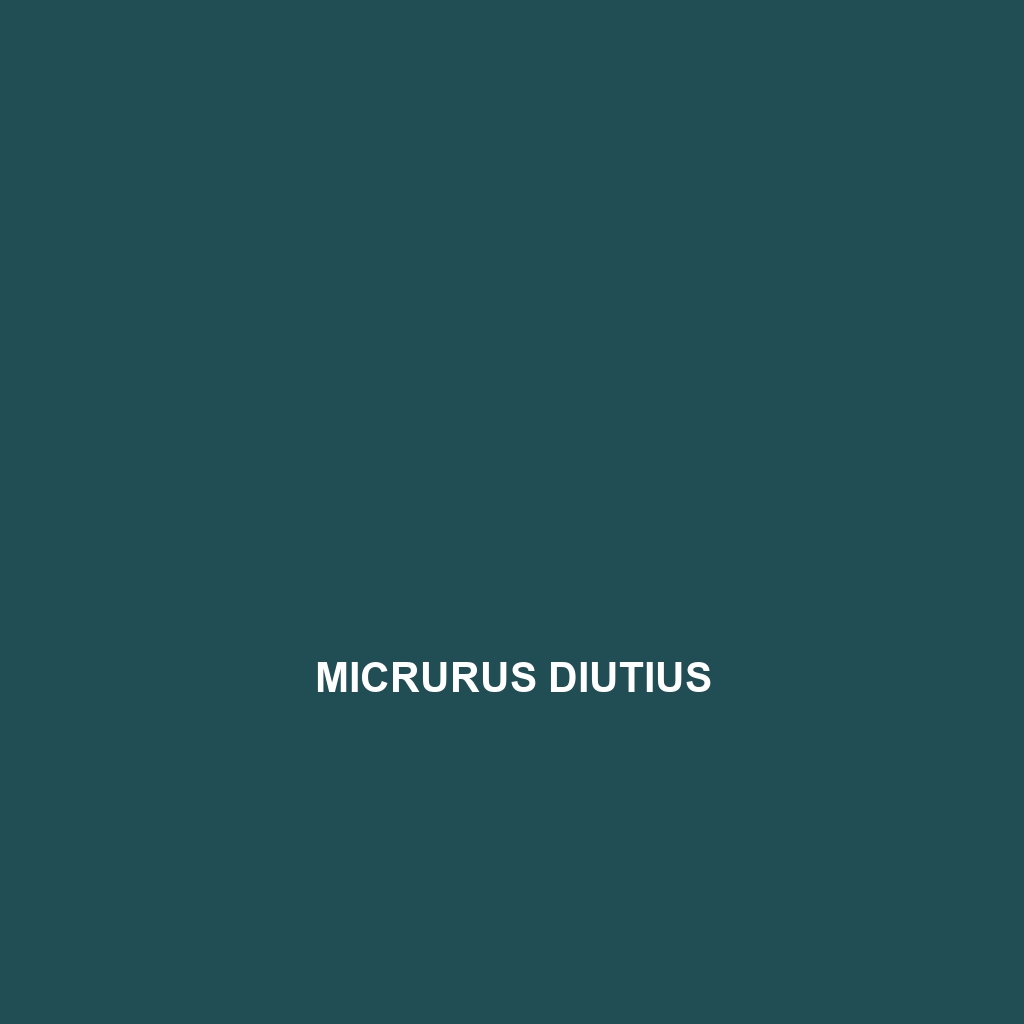Common Name
Micrurus diutius
Scientific Name
Micrurus diutius
Habitat
Micrurus diutius, commonly referred to as the Western Coral Snake, is primarily found in various temperate forests, rainforests, and coastal scrub environments. This species thrives in the humid and tropical regions of Central America, particularly in countries such as Costa Rica, Nicaragua, and Honduras. The snake prefers habitats that provide ample cover, such as leaf litter, dense vegetation, and rocky outcrops, which help it to evade predators and hunt for prey. The climate in these regions is typically warm and humid, with abundant rainfall, contributing to the lush biodiversity that supports this species. The presence of both dry and wet areas allows Micrurus diutius to adapt and forage effectively throughout the year.
Physical Characteristics
Micrurus diutius is easily recognizable due to its striking coloration and distinctive body morphology. Adults typically measure between 60 to 100 cm (24 to 39 inches) in length. The snake features a slender body adorned with a series of vivid black and red bands, which serve as a warning to potential predators about its venomous nature. The coloration varies slightly among individuals, but the patterned bands remain a defining characteristic. The head is flat and slightly wider than the neck, with small, protruding eyes that enhance its vision in low-light conditions. This coloration and body structure not only aid in camouflage but also intimidate potential threats, cementing Micrurus diutius as a well-adapted predator within its ecosystem.
Behavior
The behavior of Micrurus diutius is characterized by its elusive nature and primarily nocturnal habits. Active mainly at night, the snake utilizes its heightened senses to forage for prey and avoid detection by predators. During daylight hours, it often seeks refuge in burrows, under leaf litter, or among dense foliage. Mating rituals typically occur in late spring to early summer, where males engage in intricate courtship displays. Social interactions between individuals are minimal, as Micrurus diutius is generally a solitary creature. Notably, this species is known for its unique defensive behaviors; when threatened, it may flatten its body or vibrate its tail, mimicking a rattle, to deter predators.
Diet
Micrurus diutius is a carnivorous species that primarily preys on small vertebrates, particularly other snakes and lizards. Its diet also includes frogs, rodents, and occasionally birds. This snake possesses potent venom, which it uses to immobilize its prey before consumption. The species exhibits precise hunting strategies, often ambushing unsuspecting targets or utilizing its keen sense of smell to locate them. Due to its venom, Micrurus diutius is an effective predator, playing a critical role in maintaining population dynamics within its habitat.
Reproduction
The reproductive cycle of Micrurus diutius occurs annually, with mating typically taking place during the spring months. After fertilization, females lay a clutch of approximately 5 to 15 eggs in safe, concealed locations such as rotting logs or deep leaf litter. The incubation period lasts around 60 to 70 days, after which hatchlings emerge fully developed, measuring about 20 to 25 cm (8 to 10 inches). Parental care is absent in this species, as the young are independent from birth, capable of hunting and avoiding predators shortly after emergence. This reproductive strategy maximizes the chances of survival for the offspring in their complex habitat.
Conservation Status
According to the International Union for Conservation of Nature (IUCN), Micrurus diutius is classified as being of “least concern” in terms of conservation status. However, habitat loss due to deforestation, agricultural expansion, and urban development poses potential threats to its population stability. While the species remains relatively common, ongoing conservation efforts are essential to protect its natural habitats and mitigate the impact of human activities. Educational programs and habitat preservation initiatives are crucial in raising awareness about the ecological importance of coral snakes in maintaining biodiversity.
Interesting Facts
Micrurus diutius is not only fascinating for its appearance and behavior but also for its unique adaptations. Some individuals exhibit a remarkable ability to mimic the coloration of non-venomous snake species, aiding in their camouflage. Additionally, their venom, primarily neurotoxic, is known for delivering a potent bite that can cause severe symptoms in humans; thus, they should be treated with caution despite their reclusive nature. This species also has a unique ability to withstand particular environmental changes, showcasing resilience in varying conditions.
Role in Ecosystem
Micrurus diutius plays a significant role in its ecosystem as both a predator and a prey species, impacting population dynamics among various reptiles and small mammals. As a top predator, it helps control the populations of its prey species, thus maintaining ecological balance. Furthermore, being a part of the food web, it serves as a food source for larger predators, including birds of prey and larger snakes. Its unique behavior and dietary habits contribute to the overall health and diversity of its habitat, underscoring its importance as a keystone species in the complex interactions of tropical ecosystems.
